Improving the quality and convenience in the manufacture of boards
 The time spent on making boards for a particular development or project often has an impact not only on the directness of the hands, but also on the tools that have to be used, and often, with high-quality equipment, an extraordinary amount of nerve cells is saved. About my transition to a new level of convenience in two stages of manufacturing, namely, in the etching of boards and drilling, as well as minor drawbacks that surfaced will be described below.
The time spent on making boards for a particular development or project often has an impact not only on the directness of the hands, but also on the tools that have to be used, and often, with high-quality equipment, an extraordinary amount of nerve cells is saved. About my transition to a new level of convenience in two stages of manufacturing, namely, in the etching of boards and drilling, as well as minor drawbacks that surfaced will be described below.To begin with, there was originally:
- Etching occurs in an unsurpassed bowl from instant noodles by the easiest method, including immersion, which almost spoiled the two-sided charge due to the difference in copper coke circulation, etching, on average, takes from 25 minutes to an hour with a tail and a bunch of nerves, the maximum size boards - 100x90 mm.

- The holes are drilled using the DP 25 slider with a button attached with resin tape and SE charging. Drilling an average scarf into 190 holes takes about 15 minutes, which is about 4-5 seconds per hole. Plus, there is a misalignment during drilling, leading to a mismatch of layers, etc.
Dvizhechek like this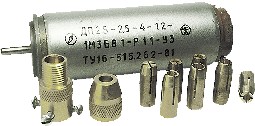
The next steps were pushed by a spoiled double-sided board, which was first overgrated due to the fact that I had etched the second side in the park, and then finished it off by missing the second axis angle when drilling and, of course, missed the second layer past pyatakov.
')
Maximize the microdrill:
The movement began with the purchase of a container for etching, and a bulk container from a nearby supermarket fell under the distribution:
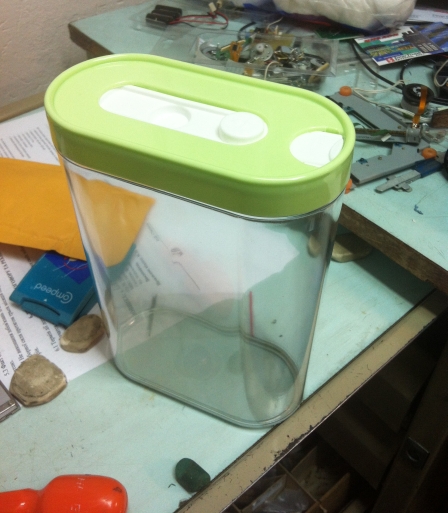
Issue price - 27 hryvnia or 104 rubles.
A bed for a hand drill was also purchased at a hardware store (there were no free suitable mechanisms, and the price seemed reasonable). Issue price - 172 UAH. or 662 rubles.
To power the microdrill, I identified the old AT-BP and soldered a simple PWM to control the speed in one of the hundreds of circuits. PWM pinned on the lid of the BP, which abruptly acquired the title of Radiator.
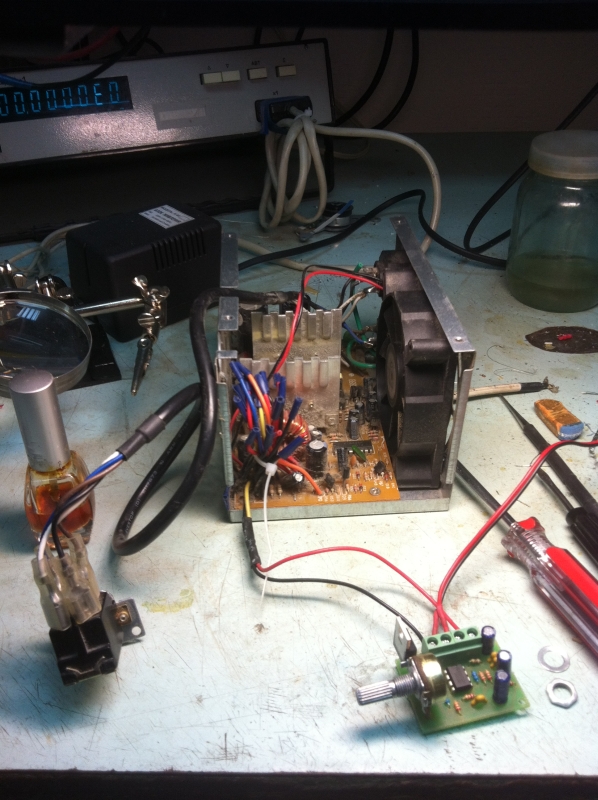
When assembling, an interesting bochin came out, when the output fielder is hooked onto the body with a screen, at Shim it goes slate. The problem is solved by gluing the transistor through a flexible PCB and thermal grease.
Then it remains to bring together the diameter of my dvizhochka and the seat in the machine for the "adult" drill. The issue is resolved “in Brazilian style”, an almost deceased roll of wide scotch tape is cut along, perpendicular to the axis, then a segment is cut out. The motor is carefully wrapped in a couple of layers with resin tape to give adhesion and wrapped with tape from an adhesive tape roll according to the principle “where the tape does not hold, do not weld it”. The power button is installed on the rack of the laboratory table, the speed regulator is displayed on the cover of the PSU.
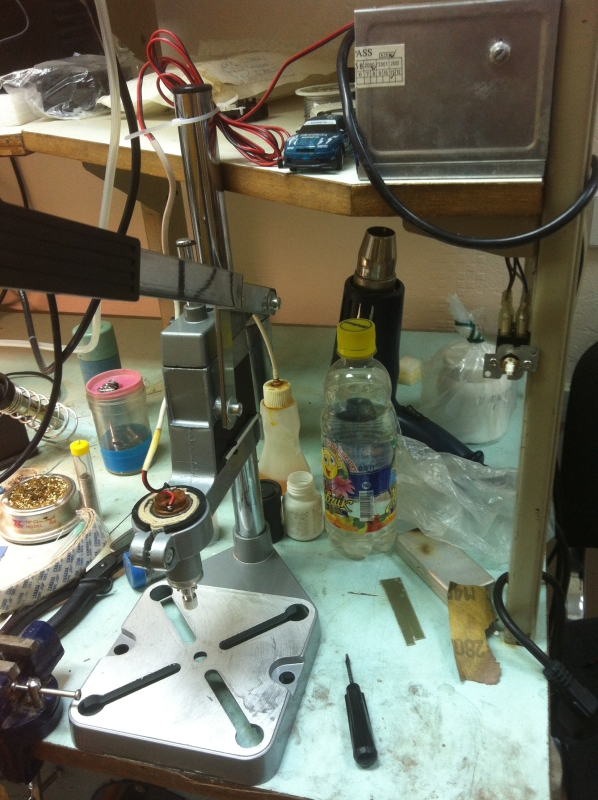
For backlighting, I stuck the remnants of a flashlight on a slide:
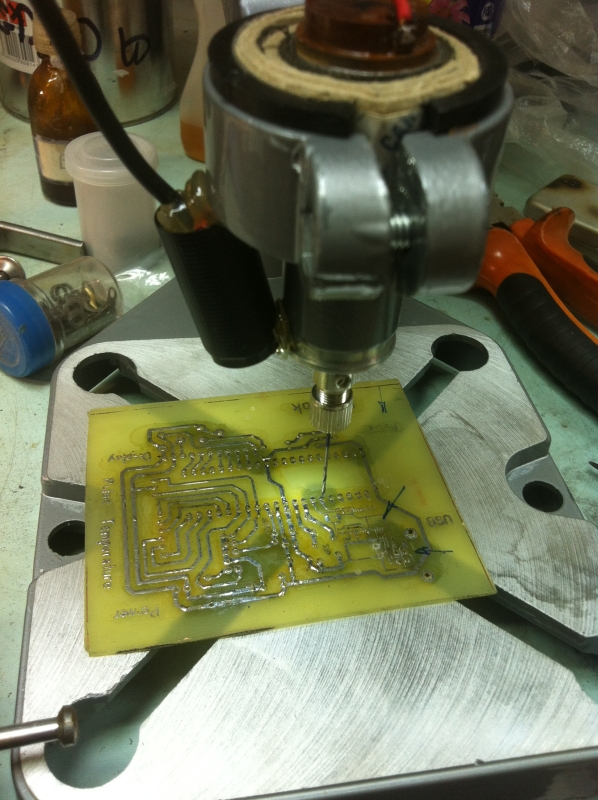
It works perfectly, one minus - the return spring is very powerful, designed for a weight of 1-2 kg, you need to lean all the weight on the drive lever. Solution - lowered the original height to a half cm, works by pressing with your fingertips.
Officially, at the moment, the work on the drilling machine is over.
Shake or mix. Magnetic stirrer.
The next step was to improve the etching process for the boards. Looking at my colleagues at the thermal laboratory, I spied the solution. I have long wanted to make a magnetic stirrer. The base was taken as a broken tube tripod and burned laboratory tile.

A four-phase motor with native fasteners, three condeichs and a variable-speed drive for adjusting the rotational speed are screwed into the tile. All details are taken from decommissioned laboratory equipment. The drive is made of a strange leg from some object, which, apparently, was very hot (otherwise there was no such plastic) and two small magnets from the door alarm, everything was flooded with a compound, there is nothing for him to twitch.

For clarity, I checked everything with water, because in the solution you can not see anything.
The first video using the cap from the counter and a magnet with ears for mounting (5 UAH or 19 rubles), a cap to reduce circulation, as it turned out - in spite of this, in parts of the scale you can see that everything is charmingly circulating.
The second movie without a “clip”, the magnet keeps the center perfectly aligned. But the circulation is much higher.
Instead of the broken test tube holders, I adjusted the plexiglass plate to the movable mount and built hooks that are convenient for manipulating the board in solution. In order to look at the state of the board during etching, you can rotate the mixer (the stand itself, roughly speaking) 180 degrees, and lowering the capacity down turned out to be quite convenient.

It is worth noting the errors identified in the etching process. I unknowingly cut the speed to a maximum (about 200 rev / min), which resulted in irresponsible harassment and the oppression of the lower half of the board. I note that the solution is not used for the first time and the concentration of the solution is lower than recommended in the bank. For 3 minutes, the entire non-masked layer was eaten to a mark about 7 cm from the bottom of the tank. At this moment, I briefly turned my eyes to the "owl" mode and dropped the turnovers to a minimum, since I did not think about the need to turn over the board in advance, after another 6-7 minutes the rest of the board arrived.
Thus, we can conclude that the afterburner can be run for boards, the top point of which will not crawl beyond the 8 cm mark, otherwise it will be unevenly etched, in all other cases I would not exceed half the maximum rotational speed.
Result:
I was satisfied with the fee, due to the rapid etching process I did not have time to float a piece of the road that was not printed during LUT, since I adjust the non-printed places with a marker for disks, which is blurred during long-term etching.
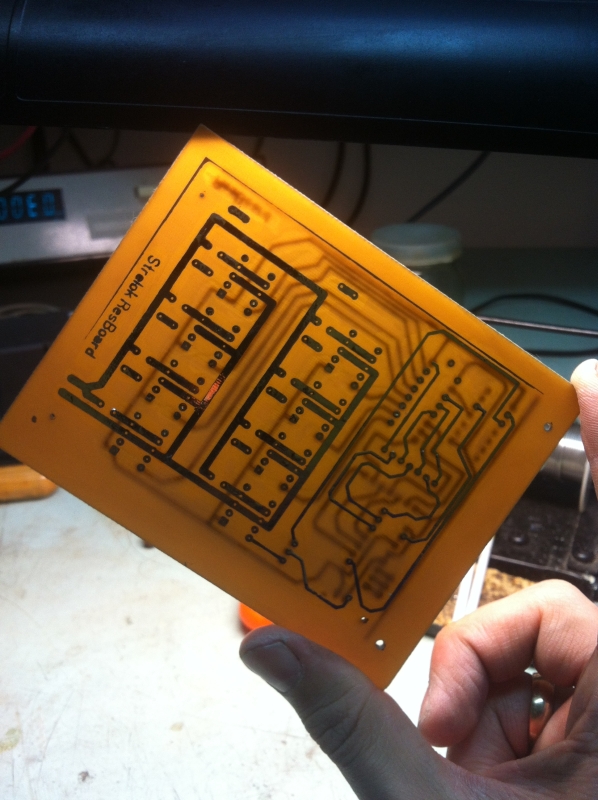
The bulk container is also pleased that it can be closed with a convenient lid and sent to storage, it looks much better than a liter jar with a plastic lid.
Next came the turn of drilling. I did not notice how I drilled the entire board, for 15–20 minutes I went through with a drill and charged the entire board. According to approximate calculations, one hole takes about 2-3 seconds, longer takes the thought process "where to drill further."
Product:

All the holes coincided, the holes are perpendicular, the board is ready in about an hour, taking into account the rearrangement of equipment and drinking tea, the nerves are intact, the mood is good.
Results summarize:
- total financial costs = 200-250 UAH or 770-960 rubles
- total time spent on equipment preparation = 6 hours
- the machine for the drill is a bit tight, but with a decrease in height everything becomes good
- with the speed of the stirrer, you must be careful because of the possible unevenness of the passage of the reaction
- job satisfaction is priceless
And finally, I want to remind you, do not forget about safety precautions - use a respirator or ventilate the room, I became interested in the process and sat like a Koschey over gold and at the exit a little withered - I burned my throat with evaporations of the solution.
Source: https://habr.com/ru/post/134053/
All Articles